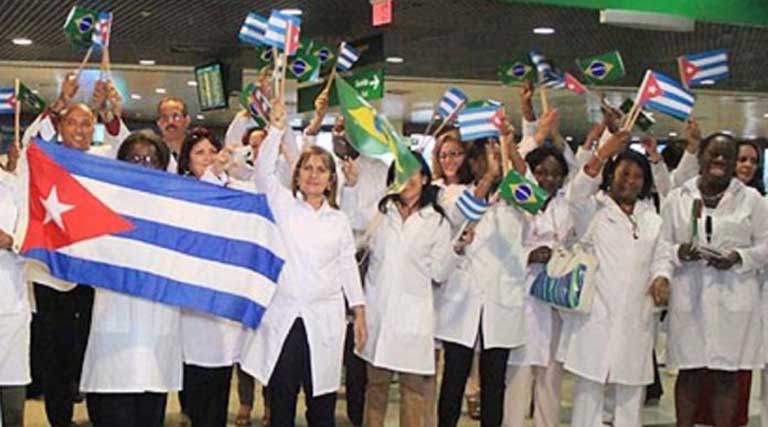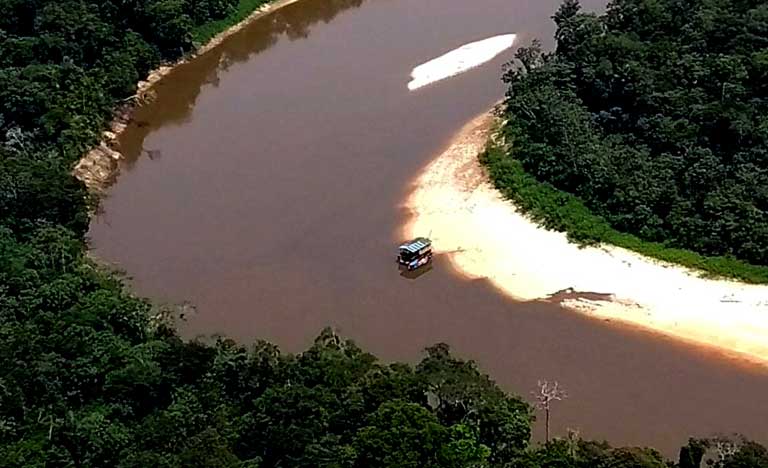- It is widely suspected that Brazil’s indigenous people will be very vulnerable to COVID-19, as they have shown little resistance to Western respiratory illnesses in the past. Isolated indigenous groups, lacking all healthcare support, would be particularly defenseless.
- UPDATE: After this story was first published, the city of Atalaia do Norte claimed that an indigenous Marubo man, suspected of coronavirus infection, tested negative for COVID-19. However, a journalist double-checking the facts found that no test was ever analyzed; when confronted, the city claimed a “communication mistake.”
- On 13 March, FUNAI potentially opened a new route for disease spread as it weakened its “no contact” isolated indigenous group rule, broadening sole decision-making power for contact from its central authority to 39 regional coordinators. Outcry quickly caused FUNAI to reverse itself, reinstating the “no contact” policy.
- Experts are very concerned about the indigenous harm coronavirus could cause, especially due to Jair Bolsonaro’s weakening of the rural public health service. Some analysts worry the health and social chaos COVID-19 would bring could cause ruralists and land grabbers to exploit the situation, seizing indigenous lands.

A Marubo indigenous man in Atalaia do Norte, Brazil, showed possible signs of coronavirus infection after coming in contact with a group of North Americans in Atalaia do Norte, the capital of a municipal district located on the border between Brazil, Peru and Colombia. The man was working as a tourist guide, and, according to Amazônia Real, visited a hospital feeling ill on Friday, 20 March.
The man was told to isolate himself in a house he shares with 14 other indigenous people. Two of his daughters, aged 9 and 12, had a fever, cough and aches, commonly seen COVID-19 symptoms. The local health system lacked capacity for testing, so samples were supposedly being sent to Manaus, 1,138 kilometers (707 miles) away. However, Atalaia do Norte has no road contact with the rest of Brazil. It takes up to three days to travel to Manaus by boat, and planes (which can fly to Manaus in three hours) are currently grounded as part of the strategy to halt the pandemic’s spread.
When questioned further about testing, Atalaia do Norte officials claimed that the samples had been sent instead to a laboratory in Tabatinga (Lafron) near the Colombian border, and that the results came back negative for coronavirus.
However, a journalist from Amazônia Real checked with the laboratory, only to learn from its director that it had done no testing for coronavirus to date. When confronted with this complete contradiction of the city’s official reporting, the health department admitted to “the communication mistake.” They said that the COVID-19 suspicion was discarded without testing and that the family had since returned to health.
Whether the family contracted the virus and suffered a mild case of COVID-19, as is common in 80% of cases, or not, remains unknown. If the family did contract the highly contagious virus, it is possible that while they were sick it could have been conveyed to other family members, who showed little or no sign of the disease, and eventually may have spread it to others in the remote region.

A looming indigenous disaster?
The arrival of COVID-19 in Atalaia do Norte, if it has already occurred, or occurs in the future, could have dramatic and dangerous consequences. This municipality, with 15,000 inhabitants and the third lowest Human Development Index (HDI) in Brazil, is the gateway to the Javari Valley Indigenous Territory, encompassing 8.5 million hectares (32,818 square miles).
The reserve is one of Brazil’s most important indigenous areas, and home to 26 indigenous groups, one of which is the Marubo, the ethnic group of the sick man. The demarcated and government-recognized reserve also contains the world’s largest number of isolated indigenous peoples. No fewer than 16 of the 26 Javari Valley groups are peoples who have chosen to remain isolated.
The official government policy today is not to contact these groups. After earlier attempts to contact isolated groups resulted in the death of at least half their population, the Brazilian indigenous agency, FUNAI, decided in 1988 to change its previous policy and leave isolated indigenous groups in peace, only contacting them in extreme circumstances. This policy has been widely seen as successful, with isolated groups managing to survive and, in some cases, apparently prosper, against all odds.
It is these groups that Ethnos360, an evangelical group formerly known as the New Tribes Mission, in open defiance of FUNAI’s policy, is planning to contact with its newly purchased helicopter to convert them to Christianity. Many anthropologists have warned that, doing so, Ethnos360 could introduce disease, as it did with the Zo’é Indians in Pará state in the 1980s, wiping out a third of their number.
There is widespread consensus among experts that it would be disastrous for Brazil’s isolated groups to come into contact with the coronavirus, which being a particularly contagious virus, could sweep like a wildfire through remote regions. Yara Marubo, a member of the Union of Indigenous Peoples of Javari Valley (UNIJAVI), told Amazônia Real: “The presence of coronavirus in Javari Valley would be devastating.”
Yara Marubo notes that while isolated groups are shielded from outside contact, outsiders move freely throughout their territory, potentially paving the way for the spread of disease. “There is an open frontier, with free movement of people, between Atalaia do Norte and Peru. There are more controls with Colombia, but even so, people come and go.”

FUNAI coronavirus missteps
Earlier this month many anthropologists feared FUNAI was going to relax its “no contact” rule, making it easier for outsiders to enter areas with isolated Indians. For the past three decades, only FUNAI’s central body — the General Coordination of Isolated and Recently Contacted Indians (CGIIRC) — could authorize contact. Then on 13 March FUNAI abruptly changed its procedures, allowing each of the 39 regional coordinators the power to grant contact authorization.
Although FUNAI presented the change in a positive light, saying it permitted “action essential for the survival of the isolated group[s],” action that might be required if the pandemic expanded into indigenous areas, many experts reacted with alarm.
International bodies, such as the Society for the Anthropology of Lowland South America (SALSA), expressed concern over “regional directors, often political appointees without adequate technical expertise,” being allowed to initiate contact.
Nara Baré, general coordinator of the Coordination of the Indigenous Organizations of the Brazilian Amazon (COIAB), noted that FUNAI under Bolsonaro has “made new appointments of heads of Regional Coordination, mainly in territories with isolated Indians. They have put military officers there and military officers obey orders.”
Leading Brazilian organizations, including the National Human Rights Council (CNDH) and the Federal Public Ministry (MPF), a group of independent litigators, called on FUNAI to revoke the measure. On 20 March FUNAI gave in to the pressure and reverted to its former policy, only giving CGIIRC authority to authorize contact.

Bolsonaro slashes rural healthcare safety net
If coronavirus does expand into remote indigenous Amazon villages, it couldn’t happen at a worse time. Brazil’s health service — greatly weakened by the Bolsonaro administration — will very likely find it nearly impossible to cope.
The indigenous health service is run by the Special Indigenous Health Sanitary Districts (DISEI), linked to the Special Secretariat of Indigenous Health (SESAI), part of the Health Ministry. According to Antenor Vaz, a former FUNAI employee and a consultant on indigenous people, this service was operating well until late 2018, largely thanks to Mais Médicos (More Doctors), a health program that brought hundreds of Cuban doctors into remote parts of Brazil.
Of the 372 doctors working within indigenous communities at the time, 301 were Cuban. “It was one of the few times that there were doctors in most indigenous territories, even if they weren’t there the whole time,” said Vaz. But just before taking office in December 2018, Bolsonaro, who had earlier criticized the fact that Cuban doctors were working in Brazil, insisted on changes in the program that the Cuban government found unacceptable. So, after some heated exchanges, the Cuba recalled its doctors. “With the departure of the Cuban doctors, the whole service has been badly damaged,” said Vaz.
The current lack of skilled doctors is compounded by the remoteness of Amazon indigenous communities a long way away from urban centers with coronavirus testing facilities, ventilators, protective gear, and other vital treatment equipment and medical experts.

SESAI used to provide transport by boat or air in emergencies. But with the drastic budget cuts under Bolsonaro, it often doesn’t have the money to do so. “We feel very vulnerable,” said Dinamam Tuxá, a lawyer and member of the executive council of the Articulation of the Indigenous Peoples of Brazil (APIB).
SESAI has told indigenous people that they should isolate themselves if they show COVID-19 symptoms. But this will be extremely difficult in cultures where large extended families live communally, sharing resources, homes and hearths. “In our culture, everyone lives in the same house — grandchildren, nieces and nephews, in-laws,” Mydjere Kayapó from the Baú Indigenous Territory in southwest Pará state told Repórter Brasil. “They [SESAI] also aren’t providing medicinal alcohol and we haven’t the money to buy it.”
Brazil’s indigenous groups have received a promise from the government that could improve the situation. According to SESAI, the health ministry will be contracting 5,811 additional doctors to help deal with the pandemic. Some will be working in indigenous villages, though no one yet knows how many or when they might arrive.
But, even if the health service is boosted, analysts worry that the social chaos that could ensue in an indigenous pandemic would offer openings for elite ruralists, land grabbers and criminal mafias to exploit the situation, taking control of ancestral lands claimed by indigenous communities and isolated Indians.

“Two fronts threaten isolated peoples,” said Vaz. “One front is targeting their territory and is led by agribusiness, mining companies and engineering companies. And the other, led by fundamentalist, evangelical missions, wants their souls.” He went on: “At this moment of crisis, FUNAI should be sending in the army to evict loggers, miners, fishermen and thieves, not coming up with a pretext for possible contact.”
Similarly, Carlos Marés, a former FUNAI president, is worried about the language that Bolsonaro has used to speak about indigenous peoples, suggesting repeatedly, even after taking office, that the Indians, themselves, want to be assimilated and to put their land to economic use, something that very few favor. Marés fears that the government will take advantage of the epidemic to open up indigenous communities in order to “make room” for unbridled economic exploitation. “It is horrible, just thinking of this makes me ill,” he told Repórter Brasil. “But if [the government] wants to exterminate the Indians, this epidemic is a chance.”
Banner image caption: These Sapanawa Indians, living near the Brazil / Peru border made contact in 2014. Isolated indigenous people like them are now likely at high risk of coronavirus. © FUNAI/Survival International.
UPDATE: At the time of this article’s original publication, the results of the COVID-19 test in question were unknown. Then in the hours after publication, the city of Atalaia do Norte claimed that the Marubo indigenous man had tested negative for COVID-19. However, an Amazônia Real journalist checked with the laboratory that officials said had done the test, only to learn from the lab’s director that it had done no coronavirus testing. When confronted with this contradiction, the health department admitted to “the communication error.” The three indigenous people who had symptoms similar to COVID-19 have since returned to health, though no one knows whether or not they may have been infected with a mild case of COVID-19, potentially spreading it to other family members and beyond, or not.
FEEDBACK: Use this form to send a message to the author of this post. If you want to post a public comment, you can do that at the bottom of the page.
